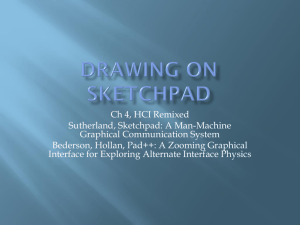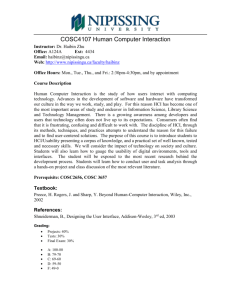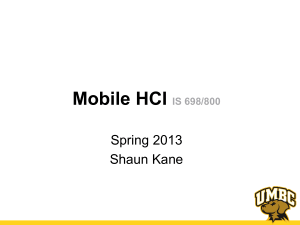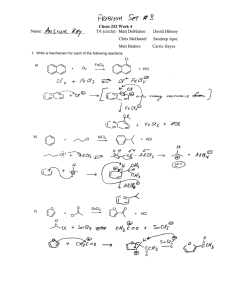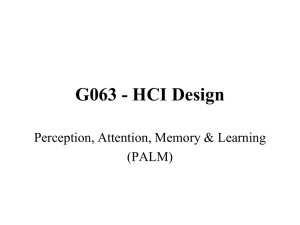A pilot study of the evolution of HCI
advertisement
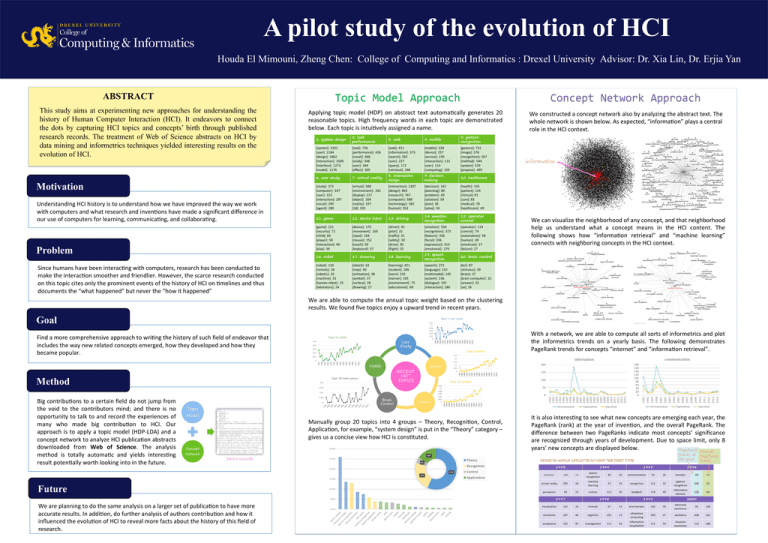
A pilot study of the evolution of HCI Houda El Mimouni, Zheng Chen: College of Computing and Informatics : Drexel University Advisor: Dr. Xia Lin, Dr. Erjia Yan ABSTRACT This study aims at experimenting new approaches for understanding the history of Human Computer Interaction (HCI). It endeavors to connect the dots by capturing HCI topics and concepts’ birth through published research records. The treatment of Web of Science abstracts on HCI by data mining and informetrics techniques yielded interesting results on the evolution of HCI. Topic Model Approach Applying topic model (HDP) on abstract text automa2cally generates 20 reasonable topics. High frequency words in each topic are demonstrated below. Each topic is intui2vely assigned a name. Concept Network Approach We constructed a concept network also by analyzing the abstract text. The whole network is shown below. As expected, “informa2on” plays a central role in the HCI context. Motivation Understanding HCI history is to understand how we have improved the way we work with computers and what research and inven2ons have made a significant difference in our use of computers for learning, communica2ng, and collabora2ng. We can visualize the neighborhood of any concept, and that neighborhood help us understand what a concept means in the HCI content. The following shows how “informa2on retrieval” and “machine learning” connects with neighboring concepts in the HCI context. Problem Since humans have been interac2ng with computers, research has been conducted to make the interac2on smoother and friendlier. However, the scarce research conducted on this topic cites only the prominent events of the history of HCI on 2melines and thus documents the “what happened” but never the “how it happened” We are able to compute the annual topic weight based on the clustering results. We found five topics enjoy a upward trend in recent years. Goal Find a more comprehensive approach to wri2ng the history of such field of endeavor that includes the way new related concepts emerged, how they developed and how they became popular. With a network, we are able to compute all sorts of informetrics and plot the informetrics trends on a yearly basis. The following demonstrates PageRank trends for concepts “internet” and “informa2on retrieval”. Method Big contribu2ons to a certain field do not jump from the void to the contributors mind; and there is no opportunity to talk to and record the experiences of many who made big contribu2on to HCI. Our approach is to apply a topic model (HDP-­‐LDA) and a concept network to analyze HCI publica2on abstracts downloaded from Web of Science. The analysis method is totally automa2c and yields interes2ng result poten2ally worth looking into in the future. Future We are planning to do the same analysis on a larger set of publica2on to have more accurate results. In addi2on, do further analysis of authors contribu2on and how it influenced the evolu2on of HCI to reveal more facts about the history of this field of research. Manually group 20 topics into 4 groups – Theory, Recogni2on, Control, Applica2on, for example, “system design” is put in the “Theory” category – gives us a concise view how HCI is cons2tuted. It is also interes2ng to see what new concepts are emerging each year, the PageRank (rank) at the year of inven2on, and the overall PageRank. The difference between two PageRanks indicate most concepts’ significance are recognized through years of development. Due to space limit, only 8 years’ new concepts are displayed below.
